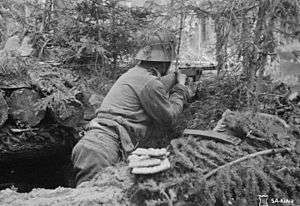Battle of Vuosalmi
| ||||||||||||||||||||||||||||||
The Battle of Vuosalmi (also known as the Battle of Äyräpää-Vuosalmi) – the main bulk of it – lasted from July 4 to July 17, 1944. It was fought during the Continuation War (1941–1944), a part of World War II, between Finland and the Soviet Union.
Background
After the Soviets saw that they had failed in the Battle of Tali-Ihantala against the Finnish defenders in the late June and early July 1944, they tried to break the Finnish positions in Vuosalmi (now Druzhnoye) and encircle the southern part of the Finnish forces in the Karelian Isthmus. Soviet forces of the 23rd Army in the region had made unsuccessful low-scale attacks against the Finnish defenses for nearly two weeks at Äyräpää region. Lack of success from the 23rd Army's performance lead to change of command on July 3.
Order of Battle
Finnish
Finnish defenses on the Vuosalmi consisted initially with only the 2nd Division (Martola, later Blick). But this was later reinforced with the Armored Division (Lagus) after the battles in the Tali-Ihantala region started to slow down.
Soviet
Soviet Leningrad Front's 23rd Army (Svetsov) was assigned with the task of making a crossing and a breakthrough at Vuosalmi. For this task 23rd Army assigned first the 98th Rifle Corps and later switched it to the 115th Rifle Corps.
- 98th Rifle Corps (Anisimov)
- 92nd Rifle Division
- 281st Rifle Division
- 381st Rifle Division
- 115th Rifle Corps (Kozatsek)
- 10th Rifle Division
- 92nd Rifle Division
- 142nd Rifle Division
The battle
The Finnish positions were very unfavorably located in the ridge of Äyräpää, with the wide River Vuoksi behind. Though the position was very unfavorable, the Äyräpää ridge dominated the lower lands on the northern shore requiring the defensive lines to be placed on the ridge. The Red Army 98th Corps started heavier attacks on July 4 and heavy battles raged for control of the ridge until July 9 when Finns finally withdrew to the northern shore. Soviet 115th Corps then continued the attack and crossed the Vuosalmi on July 9.
Soviet 115th Corps reinforced the bridgehead and had all its three divisions in the bridgehead on July 11. Finns also received reinforcements in form of the depleted Finnish Armored Division directly from Ihantala and on July 11 both sides were attempting to attack simultaneously. Attempts on both sides were halted when they ran into attacking enemy formations. Though Soviets now had access to the fields on the northern side, which were advantageous to the Soviet armor, the Finns were able to stop all further Soviet advances. The following Finnish counterattacks in Vuosalmi at this point amounted to not much success either, and thus both sides were on defensive here in mid-July, 1944.
The Finnish artillery fired altogether over 122,000 rounds of ordnance in Äyräpää and Vuosalmi, from June 20 to July 17, 1944 – the same amount as in the Battle of Tali-Ihantala, which was fought during exactly the same time period in a nearby vicinity, on the relatively narrow Karelian Isthmus of Finland.
Aftermath
The commander of the Soviet Leningrad Front, Marshal Leonid Govorov criticized heavily the 23rd Army, 98th Corps and 115th Corps commanders when the offensive in Vuosalmi had not yielded any concrete results despite of the intolerably heavy casualties.
Bibliography
- Raunio, Ari; Kilin, Juri (2008). Jatkosodan Torjuntataisteluita 1942–44. Keuruu: Otava.
